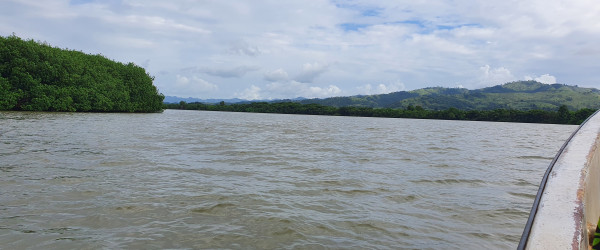Jubilee's Policy Director, Fyfe Strachan, visited Fiji in April 2022 to meet with partner organisations and build our shared work with communities affected by black sand mining. Here she recounts a trip to Ba, where a black sand mining operation has been underway since 2019.
“Take your shoes off and come stand in the river,” says Tevita Naikasowalu, the Justice, Peace and Integrity of Creation Coordinator for the Columban Mission in Fiji. “Feel the black sand under your feet. Under your feet are the shrimp, crabs and clams that have been here for thousands of years. This is what we are here to protect.”
Tevita and I are at the Ba River, close to the site of Amex Resources’ offshore black sand mining operation. We have just finished a discussion in a nearby church hall, where local community members have reported that they can see mounds of sand beginning to form in the ocean, like islands cropping up where islands are not supposed to be. We are here to see the sand islands for ourselves.
The mining at the mouth of the Ba River began in earnest around 2019. Magnetite-rich black sand is dredged from the seafloor and then pumped through a magnetic separator, where the iron content is separated from the main part of the sand. The remaining sand is then returned to the sea floor while the iron is shipped to Lautoka to be exported.
In a small motorboat with some concerned leaders from a nearby village, we head out to the river mouth, veering into the wide, open sea, careful to stay outside the area designated as the mining zone. This is now the standard route when villagers from along the Ba River go out to catch fish. Going around the mining area takes longer and uses more fuel, leaving less money in their pockets after the fish have been sold.
From a distance, I can see what looks like a land mass on the horizon – my guides tell me this is the dumped sand they are talking about. A dredging pipe rests on top of the sand islands. Two barges float nearby. The magnetic separator is not there – I am told that it is off for repairs. But the sand islands are an ominous sign of the changes to the natural environment that are coming from this project.
The project’s Environmental Impact Assessment, undertaken in 2011, briefly discusses what will happen with what is known as “dredge spoils”, the sand remaining after the magnetite has been removed. It states that the “proposed disposal of most of the dredged spoils by ARL [Amex Resources Limited] is to wash them back into the Ba River Delta spreading next to the entire area of proposed dredging”. It also proposes a second option – that the leftover sand would be recycled and given to the villages of Votua and Nawaqarua for riverbank stabilisation and reclamation. From what we can see, neither of these approaches has materialised. Instead, it looks like the sand has been dumped directly under the dredging barge, left to pile up in mounds.
Large-scale dredging operations like the Ba Ironsands Project can have harmful impacts on marine life. A 2016 study analysed multiple ways that dredging operations can impact on fish, including through sediment suspended in the water, underwater noise and the release of toxic chemicals. It found evidence of a range of impacts – from changes in fish feeding and spawning behaviour to fish deaths. Among their conclusions, the authors stress the importance of managing the disposal of contaminated sediment.[1]
The experience of people along the Ba River bears this out. In 2012, shortly before the project was approved, the Fiji Fisheries Department produced a report on the likely impact of the project on fish. At that time, people in Ba reported that they were already seeing a decline in fish due in part to previous flood mitigation dredging as well as flooding and logging along the river. They expressed concern about the further stress caused by this project. The Fisheries Department’s report concluded that the “sand extraction project could be very destructive and could bring all the community’s efforts for resource conservation to nought [sic], and thus weaken the noble objective of preserving the marine environment for the wellbeing of the upcoming future generations”. With the project underway, some people in Votua and surrounding villages share this worry.
To manage impacts like this, the Fijian Environmental Management Act requires companies to come up with an Environmental Management Plan for their projects, setting out what the company will do to manage potential adverse environmental impacts. This would be the document that describes how the project operators will ensure that fish and kai (river mussel) stocks are not damaged and that the project does not cause coastal erosion. But no-one I have spoken to in the Ba area has ever seen an Environmental Management Plan for the project. If one exists, it has not been widely circulated, meaning local communities are in the dark about what changes to expect and what actions they can rightfully expect to be taken to protect their fishing grounds.
In the meantime, communities along the river watch the hills of sand forming off the coast and hope that the project’s impacts will not damage the marine ecosystems that are vital to their way of life.
By Fyfe Strachan
[1] A Wenger, E Harvey, S Wilson, C Rawson,S J. Newman, D Clarke, B J. Saunders, N Browne, M J Travers, J L Mcilwain, P. L. A. Erftemeijer, J A Hobbs, D Mclean, M Depczynski, R D Evans, ‘A critical analysis of the direct effects of dredging on fish’, Fish and Fisheries. 2017;18:967–985.
